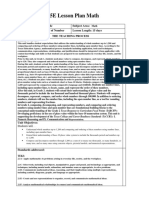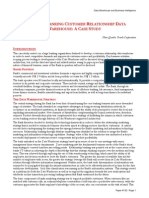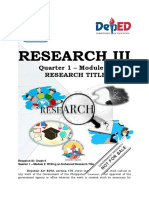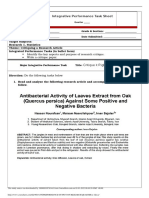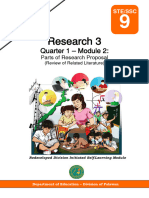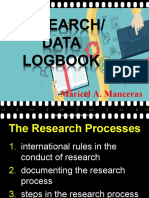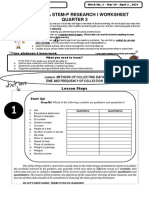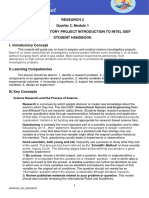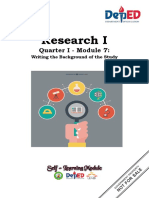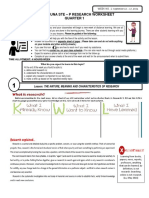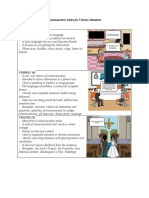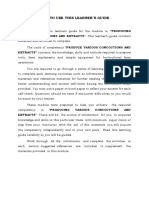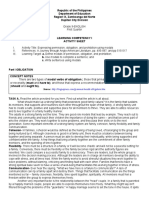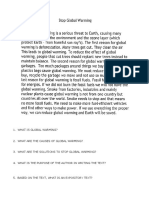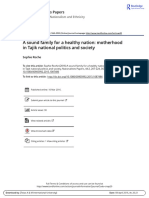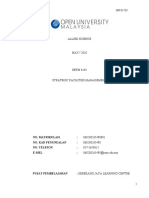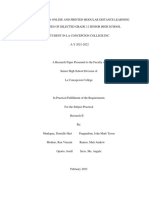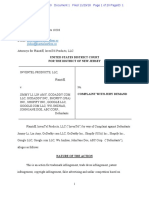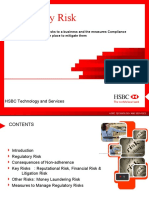Research 9 Modules 1 and 2
Uploaded by
Reinopeter Koykoy Dagpin LagascaResearch 9 Modules 1 and 2
Uploaded by
Reinopeter Koykoy Dagpin Lagasca9
RESEARCH 9
Quarter I
Module 1 - 2
Note: Do not write anything on this SLM. Use separate answer sheet.
Learning Competency
Writing an Enhanced Research Title
Determine the process of making a good Science investigatory research title; and
Write an enhanced Science investigatory research title.
Lesson
1 Writing an Enhanced Research Title
Review
Direction: Choose the correct answer. Write your answer on your answer sheet.
1. It is a research that uses scientific methods to study and test an idea about how something works. It
involves researching a topic, formulating a working theory (or hypothesis) that can be tested, conducting
the experiment, and recording and reporting the results.
A. Basic/Pure Research C. Library research
B. Science Investigatory Project (SIP) D. None of the above
2. It is a quality of a good researcher who is trustful in the conduct of his research and
declares valid results.
A. Smart C. Loyal
B. Honest D. Respectful
3. Which of the following are excellent sources for research topics?
A. Theory C. Replication of prior research
B. Personal experience D. All of the above
4. What is the reason for consulting handbooks, yearbooks, encyclopedias, or reviews in
the initial stages of identifying a research topic?
A. They are readily available.
B. They are primary sources.
C. They provide an overview of the issues related to a topic.
D. They avoid reporting statistical data so one can interpret the results more readily.
5. Jane identified her research topic as "Cigarette smoking." She realized that her topic was
far too broad. Which of the following is likely to have led to that conclusion?
A. There is too much information written on the topic to understand them all.
B. It is difficult to organize the material she was collecting in an effective manner.
C. It hard to combine all of the information you are finding out about it
D. All of the above
Lesson Proper
How to enhance your research topic to make a research title?
Try to assess your topic if it applies or demonstrates scientific principles or attempts to
provide new knowledge.
Example:
You decided that your title for your research is demonstrating concepts of Chemistry:
“Plant-Based Rat Killer”, but you realized that the topic/title “Plant-Based Rat Killer” is too
broad. What made you realize that the topic is too broad?
The topic is too broad because:
- You find too many sources or related studies about plant-based rat killer (such as
using lemon grass, calendula, and camphor extract) --more than you could reasonably
look through.
- You realize you won't have enough space in your paper to cover everything about
your topic that you want to cover.
- you feel like your topic is pulling you in lots of different directions--it's hard to
combine all of the information you are finding out about it
What are you going to do to narrow your research topic?
A topic is too broad to be workable when you find that you have too many different (but
oftentimes remotely related) ideas about that topic. While you want to start the research process
with as many ideas as possible, you will want to narrow your focus. Your topic is too broad if you
can find thousands of sources when conducting a simple library or Internet search. For example,
conducting a search on "Plant-Based Rat Killer" will provide you with different types of plants
that can be used to kill rats such as lemon grass, calendula, and camphor extract (just to name a
few). When this happens, you narrow your topic by choosing a specific plant. Make sure that you
are allowed to make a parallel research or continuing research and investigation about it.
What are you going to do when it is not allowed to make the same copy of a related
research? Search and read on the internet about other plants that have rodenticides (poison used
to kill rodents) properties under laboratory and field conditions. Also consider the availability of
the raw materials. For instance, you search and read from a previous study on the internet about
Sweet Cassava (Euphorbiaceae) which provides a rodenticidal effect but upon reading the
recommendation, it is stated that the smell is unpleasant or unattractive to rats. What will be your
next step? At this point, you may think of browsing scents that will attract the rats, and upon
browsing you discover peppermint. Is it already the end? Can you now make a good research
title? Well, it’s not yet the end, instead search or browse again on the internet if there are existing
studies published about sweet cassava (Euphorbiaceae) and peppermint extract as a rat killer. If
you haven’t found the same study, then you can now make a good research topic/title for your
study.
How to enhance your research title?
You must know the characteristics of a good research title. A good research title must
predict the content of the research study or paper, interesting to the readers and contain important
keywords that will make it easier to be located during a keyword search.
Example:
Not too good research title:
Sweet Cassava (Euphorbiaceae) and Peppermint (Mentha × piperita) as a Rat Killer
Enhanced Research title:
Rodenticidal Effect of Sweet Cassava (Euphorbiaceae) and Peppermint (Mentha × piperita)
Extract on House Rats (Rattus rattus)
Tips:
Selecting a topic can be the most difficult part of doing research. Defining and refining your topic
is an ongoing process. Be prepared to change the focus of your topic as you gather more
information.
These are some general guidelines to follow:
Interesting: Select a subject you can get interested in. Since you will be spending a
considerable amount of time researching your topic, you will want it to be something that
holds your interest and that of the reader.
Focus: Make sure that your topic isn't too narrow or too vague. If the topic is too broad, you
will be overwhelmed with information. If the topic is too narrow, you may not be able to
find enough information for your research paper. A good first step is trying to ask
a question about your topic to give you both a focus and structure.
Broad Topic: Pepper as an ointment
Manageable and Narrowed Topic:
Anti-inflammatory effects of Serrano pepper (Capsicum annuum) extract as a topical ointment on
carrageenan-induced Swiss mice
Task
Direction: Identify whether the following research titles are good research titles or not. Write G if
the research title is good and N if not. Write your answer on your answer sheet.
________1. Sawdust as an alternative source for corkboard
________2. Herbal leaves produced herbal ointment
________3. Styrofoam and powdered oyster shells as tiles: A comparative study to commercial
tiles
________4. Dalupang (Urena lobata) as a potential source of commercial fibers
________5. Methane outputs of vegetable and fruit peelings
Assessment
Direction: Practice narrowing down the broad topic below and make a good research title. You
will not actually be writing a paper; the goal is to practice working from a general topic
to one that is specific, but not too narrow. Write your answer on your answer sheet.
Broad Topic: Germicidal Soap
Learning Competency
Identify and assess a credible source for your research study.
Determine the process of evaluating research sources from the internet; and
Assesses credible research sources from the internet.
Lesson
Evaluating Research Source from the
2 Internet
Lesson Proper
Evaluating Sources from the Internet
It can be very difficult, especially when conducting research using the Internet, to determine the
reliability and validity of a website. Any basic guidelines are listed below to help you pick
trustworthy tools and use them to learn precise details about a given subject.
Reliable Sources' Criteria
A. Authority - The credibility of the information being given is checked by professionals.
Verify the credentials of the author.
For example, Dr. Robert Green is a physician who was in charge of a study that yielded
concrete findings or presented such statistical evidence to the Center for Disease Control.
Authority also means the one providing data on the web is credible.
Examples of ways you can determine the type of organization that provides the
content for a particular website are as follows.
1. Sites that ends in...
.edu -are traditionally educational institutions and a good source of learning in general.
.gov -are official portals and basically good statistical knowledge sources.
.org- are non-profit entities that are mostly set up as a public benefit. Remember: keep
on
the lookout for stereotypes and political motives.
Example: You might be able to check whether you are searching for knowledge about
experimental testing policies .gov pages for statistics on legislation and laboratory rules
relating to the safe treatment during tests in animal and chemical studies. Pages
concerned with particular laboratory policy and law prejudices are likely to be
identified
on .org (testinglabs.org or clinicaltesting.org) websites.
2. Magazines or journals online
As support for arguments and facts, these papers also contain a comprehensive
bibliography and site specific tools.
3. Sources of web news
Just as local stations, nearly every network and cable television outlet has an internet
presence. It is necessary to remember that they are still active in the film business as
they
provide news and can offer any evidence that is viewpoint vs. fact-based.
4. Television / Internet news broadcasts on video
When watching images, bear in mind that the source might not be reliable if it is not
from a source that can be reliably reported with origin, date, and key facts such as who,
what, where, where, why, and how, also known as the TRAP method.
B. Timeliness: Specifically marked on the website is the date of the details and/or the latest
change.
C. Relevance: It indicates the relevance of the topic of the article. A source is important when
addressing literature if the information refers to the topic that you are focused
with.
D. Purpose: The reason why the information exist is stated.
Task
Direction: Read the article below and use the checklist to evaluate the credibility of the article be.
Copy the checklist on your answer sheet and put a check mark that applies to the
criterion that applies to the article.
BENEFITS OF ALFALFA INTERSEEDING INCLUDE REDUCED RESIDUAL SOIL
NITRATE FOLLOWING CORN PRODUCTION
First published: 08 September 2021 | https://doi.org/10.1002/ael2.20053
AUTHOR CONTRIBUTIONS
William Osterholz: Conceptualization; Formal analysis; Investigation; Visualization; Writing-original
draft; Writing-review & editing. Matthew D. Ruark: Conceptualization; Writing-review & editing.
Mark Renz: Conceptualization; Funding acquisition; Writing-review & editing. John H. Grabber:
Conceptualization; Funding acquisition; Investigation; Writing-review & editing.
ABSTRACT
Interseeding alfalfa (Medicago sativa L.) into corn (Zea mays L.) silage can increase forage
production, but the effects on soil nitrate pools remain unknown. We compared soil nitrate pools
during and after interseeded alfalfa establishment in corn with pools during production of solo-
seeded corn followed by spring-seeded alfalfa. Nitrogen (N) fertilizer was applied at three rates as a
preplant broadcast or a 50:50 split between preplant broadcast and banded sidedress applications.
During corn growth, soil nitrate levels from 0 to 30 cm were increased by higher N rates but were
usually similar for both production systems. However, growth of interseeded alfalfa after corn
harvest resulted in substantially lower residual fall and spring soil nitrate levels to a 90 cm depth,
particularly under the highest N rate. Additionally, interseeded alfalfa influenced spring nitrate
stratification by reducing nitrate in deeper horizons and increasing nitrate in the surface horizon.
Interseeded alfalfa can thereby reduce the risk of nitrate leaching.
INTRODUCTION
Interseeding alfalfa (Medicago sativa L.) into corn (Zea mays L.) silage is a forage production system
in which corn and alfalfa are planted together to simultaneously produce a corn silage crop and
In this study we investigated the hypothesis that interseeded alfalfa will reduce the amount of soil
establish alfalfa for subsequent forage production. The interseeding system has been shown to
increase overall forage production compared with a conventional corn silage-alfalfa rotation (Berti et
al., 2021; Grabber, 2016; Osterholz et al., 2018), and a farm budget analysis suggested interseeding
could increase farm profitability (Osterholz et al., 2020).
While economic factors often drive farmer practices, innovations in agricultural systems are needed
to reduce negative environmental impacts. Nitrate pollution of groundwater from intensive dairy
production is a major environmental concern in many humid agricultural regions (Wang et al., 1999;
Verloop et al., 2006). Corn silage production often involves high rates of nitrogen (N) fertilizer
application and a fallow period of 6+ mo after harvest, thereby creating an extended window of high
nitrate leaching potential. Interseeded cover crops can reduce soil nitrate pools and leaching
potential by increasing living cover and uptake of available soil N (Manevski et al, 2015), but the soil
nitrate benefits of interseeded alfalfa have not been quantified.
In this study we investigated the hypothesis that interseeded alfalfa will reduce the amount of soil
nitrate during and after corn silage production. Additionally, N fertilizer application rate and
approach on nitrate leaching potential in the interseeded system were explored.
DISCUSSION
Effects of interseeded alfalfa on soil nitrate during the corn growing season were limited, as the
amount of available soil N was not clearly larger in the corn monoculture than the interseeded
corn/alfalfa system at a given N rate. This result was surprising because interseeding of alfalfa
slightly decreased the dry matter yield and N uptake of corn and simultaneously increased the N
rate at which corn silage yield was maximized, suggesting competition for N between alfalfa and
corn in the interseeded system (Osterholz et al., 2021). A possible explanation was that light or
chemical cues from alfalfa altered the growth of corn in a manner analogous to that observed with
weeds, thus reducing corn N uptake and offsetting alfalfa N uptake (Afifi & Swanton, 2012; Moriles
et al., 2012). Additional research toward alleviating yield loss of corn interseeded with alfalfa is
needed.
Overall, our results show a reduction in pool size and downward movement of soil NO3– that
indicates an environmental benefit of interseeded alfalfa. Additionally, living groundcover provided
by interseeded alfalfa during and after corn production reduced runoff losses of soil by 49 to 87%, N
by 37 to 74%, and P by 37 to 81% relative to a conventional corn silage–alfalfa rotation (Osterholz et
al., 2018). As a perennial crop, alfalfa provides important environmental benefits for multiple years,
including reduced NO3– leaching and soil erosion and improved soil quality relative to annual row
crops such as corn (Randall et al., 1997; Russell et al., 2006; Hunt et al., 2019). However, forage
Assessment
Direction: Multiple choice. Choose the letter that corresponds to your answer. Write your
answer on your answer sheet.
1. What are browser searches, blogs and Wikis best used for in research?
A. Finding general information on a topic
B. Examining both sides of an argument
C. Looking for accurate and reliable information
D. Helping you determine what is true and not true about a subject
2. What domains that are considered most credible source of information?
A. .com and .net
B. .org and .com
C. .gov and .edu
D. .edu and .com
3. What are the things you should check when evaluating websites?
A. Accuracy and Currency
B. Objectivity and Authority
C. Bias and Advertisements
D. Both A and B
4. Choose which questions you could ask when trying to evaluate sources under the
criteria of authority?
A. Who is the author?
B. Can I find the authority or credentials of the publisher?
C. What if there is no author for an internet source?
D. All of the above
5. Which aspect of a source suggests that it should NOT be used as part of academic
research?
A. The information has been peer-reviewed
B. One-sided opinion statements are used
C. The author is listed
D. The information is current and citations are included
You might also like
- Lesson Plan in Grade 9 English For Quarter 379% (14)Lesson Plan in Grade 9 English For Quarter 39 pages
- Science Investigatory Project: Quarter 1 - Module 1A: The Nature of Research100% (1)Science Investigatory Project: Quarter 1 - Module 1A: The Nature of Research16 pages
- Research Methods: Simple, Short, And Straightforward Way Of Learning Methods Of ResearchFrom EverandResearch Methods: Simple, Short, And Straightforward Way Of Learning Methods Of Research4/5 (13)
- RESEARCH1 Q1 Mod7 Guidedexperiment - V3FINALNo ratings yetRESEARCH1 Q1 Mod7 Guidedexperiment - V3FINAL27 pages
- Oracle - Building A Banking Customer Relationship Data Warehouse - A Case Study - White Paper PDFNo ratings yetOracle - Building A Banking Customer Relationship Data Warehouse - A Case Study - White Paper PDF10 pages
- SLM 2 Grade 9 Research 1st Quarter Research TitleNo ratings yetSLM 2 Grade 9 Research 1st Quarter Research Title6 pages
- Research 1 q2 Mod1b Review-Of-Related-Literature Library-And-Internet-Research v2No ratings yetResearch 1 q2 Mod1b Review-Of-Related-Literature Library-And-Internet-Research v228 pages
- Performance Output On Research Quarter 2 1No ratings yetPerformance Output On Research Quarter 2 18 pages
- Research2 q4 Mod1.2 Constructingscienceprojectdisplayboard v2100% (1)Research2 q4 Mod1.2 Constructingscienceprojectdisplayboard v222 pages
- Research IV - Research Logbook and PhotodocumentationNo ratings yetResearch IV - Research Logbook and Photodocumentation45 pages
- Review of Related Literature and Studies: Research INo ratings yetReview of Related Literature and Studies: Research I12 pages
- Research I - Q1 - Module2 - Types of Scientific Research - v2 1No ratings yetResearch I - Q1 - Module2 - Types of Scientific Research - v2 125 pages
- LC3 LAS Research 1-LC3-Quarter 3 - SATIOQUIANo ratings yetLC3 LAS Research 1-LC3-Quarter 3 - SATIOQUIA5 pages
- Sdo Laguna Ste - P Research Worksheet Quarter 1: Grade 8No ratings yetSdo Laguna Ste - P Research Worksheet Quarter 1: Grade 82 pages
- Department of Education - Division of PalawanNo ratings yetDepartment of Education - Division of Palawan16 pages
- Research I: Special Science Program Quarter 3 - Module 5: Integrated Process Skills (Part 1)No ratings yetResearch I: Special Science Program Quarter 3 - Module 5: Integrated Process Skills (Part 1)18 pages
- RESEARCH III Quarter 3 Week 2 Worksheet ANOVA PDFNo ratings yetRESEARCH III Quarter 3 Week 2 Worksheet ANOVA PDF5 pages
- Essential Learning Competencies Research 1 Special Science Program100% (1)Essential Learning Competencies Research 1 Special Science Program15 pages
- Research 4 Activity Sheet Quarter 3 - MELC 2 Weeks 3-4No ratings yetResearch 4 Activity Sheet Quarter 3 - MELC 2 Weeks 3-47 pages
- The Learners Should Demonstrate Understanding of The Learners Should Be Able To..100% (1)The Learners Should Demonstrate Understanding of The Learners Should Be Able To..2 pages
- Science Class Gr8 Research 1 Q2 Module 5 WK 5 v.01 CC Released 16nov2020No ratings yetScience Class Gr8 Research 1 Q2 Module 5 WK 5 v.01 CC Released 16nov202024 pages
- LR Q4 Week1-2 Research8 CollectionAnalysis-and-PresentationNo ratings yetLR Q4 Week1-2 Research8 CollectionAnalysis-and-Presentation8 pages
- Summative Test Quarter 1 Research STE - For PrintingNo ratings yetSummative Test Quarter 1 Research STE - For Printing4 pages
- Research: Quarter 1 - Module 9 The Research ProblemNo ratings yetResearch: Quarter 1 - Module 9 The Research Problem19 pages
- Las Research 3 (Grade 9) Melc 1 Week-1-2No ratings yetLas Research 3 (Grade 9) Melc 1 Week-1-210 pages
- Research II: Special Science Program Quarter 1 - Module 2: Types of ResearchNo ratings yetResearch II: Special Science Program Quarter 1 - Module 2: Types of Research15 pages
- LAS Research 2 GRADE 8 MELC 6 Q3 Week6-ReturnedNo ratings yetLAS Research 2 GRADE 8 MELC 6 Q3 Week6-Returned11 pages
- Research I Q1 Module 7 Writing The Background of The StudyNo ratings yetResearch I Q1 Module 7 Writing The Background of The Study24 pages
- Sdo Laguna Ste - P Research Worksheet Quarter 1: Grade 8No ratings yetSdo Laguna Ste - P Research Worksheet Quarter 1: Grade 84 pages
- How to Successfully Deal with Your Dissertation DataFrom EverandHow to Successfully Deal with Your Dissertation DataNo ratings yet
- Communicative Styles For Various SituationsNo ratings yetCommunicative Styles For Various Situations2 pages
- Diction Refers To An Author's Choice of Words. When Describing The Events of Her Story, An Author Never Has Just OneNo ratings yetDiction Refers To An Author's Choice of Words. When Describing The Events of Her Story, An Author Never Has Just One10 pages
- Republic of The Philippines Bohol Island State University Main Campus CPG North Ave., Tagbilaran CityNo ratings yetRepublic of The Philippines Bohol Island State University Main Campus CPG North Ave., Tagbilaran City7 pages
- Annotation Form: Objectives Means of Verification Description of The MOV Presented AnnotationsNo ratings yetAnnotation Form: Objectives Means of Verification Description of The MOV Presented Annotations3 pages
- Students Should Not Be Allowed To Bring Mobile Phones To School100% (4)Students Should Not Be Allowed To Bring Mobile Phones To School2 pages
- 01 Roche, Sophie - A Sound Family For A Healthy Nation - Motherhood in Tajik National Politics and SocietyNo ratings yet01 Roche, Sophie - A Sound Family For A Healthy Nation - Motherhood in Tajik National Politics and Society19 pages
- Chapter 22 - Frontiers of MicroeconomicsNo ratings yetChapter 22 - Frontiers of Microeconomics22 pages
- Glorified Fasting The Abc of Fasting Paperback100% (1)Glorified Fasting The Abc of Fasting Paperback2 pages
- Ethics Requirements (Mesina, Eleanor Garcia)No ratings yetEthics Requirements (Mesina, Eleanor Garcia)4 pages
- EBFM 4103 - Strategic Facilities ManagementNo ratings yetEBFM 4103 - Strategic Facilities Management22 pages
- 13 - d26 AN - APX - 113 - 125 CIT - Data Sheet - WebNo ratings yet13 - d26 AN - APX - 113 - 125 CIT - Data Sheet - Web2 pages
- Jazan Refinery & IGCC Industrial Support Facilities Jazan, Kingdom of Saudi ArabiaNo ratings yetJazan Refinery & IGCC Industrial Support Facilities Jazan, Kingdom of Saudi Arabia5 pages
- Challenges in Online and Printed Modular Distance Learning Modalities ResearchNo ratings yetChallenges in Online and Printed Modular Distance Learning Modalities Research45 pages
- Resume:-: MAHESH ANIL POWAR. Production-Machining-About 2yrsNo ratings yetResume:-: MAHESH ANIL POWAR. Production-Machining-About 2yrs3 pages
- Lesson Plan in Science Grade 4 Copy Weather Intrument 2No ratings yetLesson Plan in Science Grade 4 Copy Weather Intrument 29 pages
- Proven Optics Awarded Servicenow 2022 Americas App Development Platform Partner of The YearNo ratings yetProven Optics Awarded Servicenow 2022 Americas App Development Platform Partner of The Year4 pages
- VC23Z Figure Drawing II Course Guide: 1. Paper and Boards (Specific Dimensions To Be Indicated Per Assignment)No ratings yetVC23Z Figure Drawing II Course Guide: 1. Paper and Boards (Specific Dimensions To Be Indicated Per Assignment)7 pages
- Regulatory Risk: HSBC Technology and ServicesNo ratings yetRegulatory Risk: HSBC Technology and Services10 pages
- Science Investigatory Project: Quarter 1 - Module 1A: The Nature of ResearchScience Investigatory Project: Quarter 1 - Module 1A: The Nature of Research
- Research Methods: Simple, Short, And Straightforward Way Of Learning Methods Of ResearchFrom EverandResearch Methods: Simple, Short, And Straightforward Way Of Learning Methods Of Research
- Oracle - Building A Banking Customer Relationship Data Warehouse - A Case Study - White Paper PDFOracle - Building A Banking Customer Relationship Data Warehouse - A Case Study - White Paper PDF
- Research 1 q2 Mod1b Review-Of-Related-Literature Library-And-Internet-Research v2Research 1 q2 Mod1b Review-Of-Related-Literature Library-And-Internet-Research v2
- Research2 q4 Mod1.2 Constructingscienceprojectdisplayboard v2Research2 q4 Mod1.2 Constructingscienceprojectdisplayboard v2
- Research IV - Research Logbook and PhotodocumentationResearch IV - Research Logbook and Photodocumentation
- Review of Related Literature and Studies: Research IReview of Related Literature and Studies: Research I
- Research I - Q1 - Module2 - Types of Scientific Research - v2 1Research I - Q1 - Module2 - Types of Scientific Research - v2 1
- Sdo Laguna Ste - P Research Worksheet Quarter 1: Grade 8Sdo Laguna Ste - P Research Worksheet Quarter 1: Grade 8
- Research I: Special Science Program Quarter 3 - Module 5: Integrated Process Skills (Part 1)Research I: Special Science Program Quarter 3 - Module 5: Integrated Process Skills (Part 1)
- Essential Learning Competencies Research 1 Special Science ProgramEssential Learning Competencies Research 1 Special Science Program
- Research 4 Activity Sheet Quarter 3 - MELC 2 Weeks 3-4Research 4 Activity Sheet Quarter 3 - MELC 2 Weeks 3-4
- The Learners Should Demonstrate Understanding of The Learners Should Be Able To..The Learners Should Demonstrate Understanding of The Learners Should Be Able To..
- Science Class Gr8 Research 1 Q2 Module 5 WK 5 v.01 CC Released 16nov2020Science Class Gr8 Research 1 Q2 Module 5 WK 5 v.01 CC Released 16nov2020
- LR Q4 Week1-2 Research8 CollectionAnalysis-and-PresentationLR Q4 Week1-2 Research8 CollectionAnalysis-and-Presentation
- Summative Test Quarter 1 Research STE - For PrintingSummative Test Quarter 1 Research STE - For Printing
- Research: Quarter 1 - Module 9 The Research ProblemResearch: Quarter 1 - Module 9 The Research Problem
- Research II: Special Science Program Quarter 1 - Module 2: Types of ResearchResearch II: Special Science Program Quarter 1 - Module 2: Types of Research
- Research I Q1 Module 7 Writing The Background of The StudyResearch I Q1 Module 7 Writing The Background of The Study
- Sdo Laguna Ste - P Research Worksheet Quarter 1: Grade 8Sdo Laguna Ste - P Research Worksheet Quarter 1: Grade 8
- How to Successfully Deal with Your Dissertation DataFrom EverandHow to Successfully Deal with Your Dissertation Data
- Diction Refers To An Author's Choice of Words. When Describing The Events of Her Story, An Author Never Has Just OneDiction Refers To An Author's Choice of Words. When Describing The Events of Her Story, An Author Never Has Just One
- Republic of The Philippines Bohol Island State University Main Campus CPG North Ave., Tagbilaran CityRepublic of The Philippines Bohol Island State University Main Campus CPG North Ave., Tagbilaran City
- Annotation Form: Objectives Means of Verification Description of The MOV Presented AnnotationsAnnotation Form: Objectives Means of Verification Description of The MOV Presented Annotations
- Students Should Not Be Allowed To Bring Mobile Phones To SchoolStudents Should Not Be Allowed To Bring Mobile Phones To School
- 01 Roche, Sophie - A Sound Family For A Healthy Nation - Motherhood in Tajik National Politics and Society01 Roche, Sophie - A Sound Family For A Healthy Nation - Motherhood in Tajik National Politics and Society
- 13 - d26 AN - APX - 113 - 125 CIT - Data Sheet - Web13 - d26 AN - APX - 113 - 125 CIT - Data Sheet - Web
- Jazan Refinery & IGCC Industrial Support Facilities Jazan, Kingdom of Saudi ArabiaJazan Refinery & IGCC Industrial Support Facilities Jazan, Kingdom of Saudi Arabia
- Challenges in Online and Printed Modular Distance Learning Modalities ResearchChallenges in Online and Printed Modular Distance Learning Modalities Research
- Resume:-: MAHESH ANIL POWAR. Production-Machining-About 2yrsResume:-: MAHESH ANIL POWAR. Production-Machining-About 2yrs
- Lesson Plan in Science Grade 4 Copy Weather Intrument 2Lesson Plan in Science Grade 4 Copy Weather Intrument 2
- Proven Optics Awarded Servicenow 2022 Americas App Development Platform Partner of The YearProven Optics Awarded Servicenow 2022 Americas App Development Platform Partner of The Year
- VC23Z Figure Drawing II Course Guide: 1. Paper and Boards (Specific Dimensions To Be Indicated Per Assignment)VC23Z Figure Drawing II Course Guide: 1. Paper and Boards (Specific Dimensions To Be Indicated Per Assignment)




